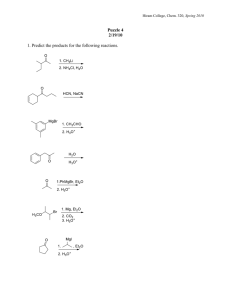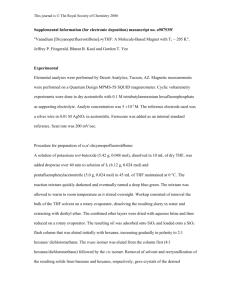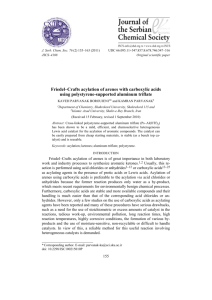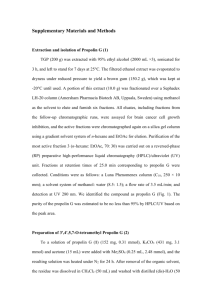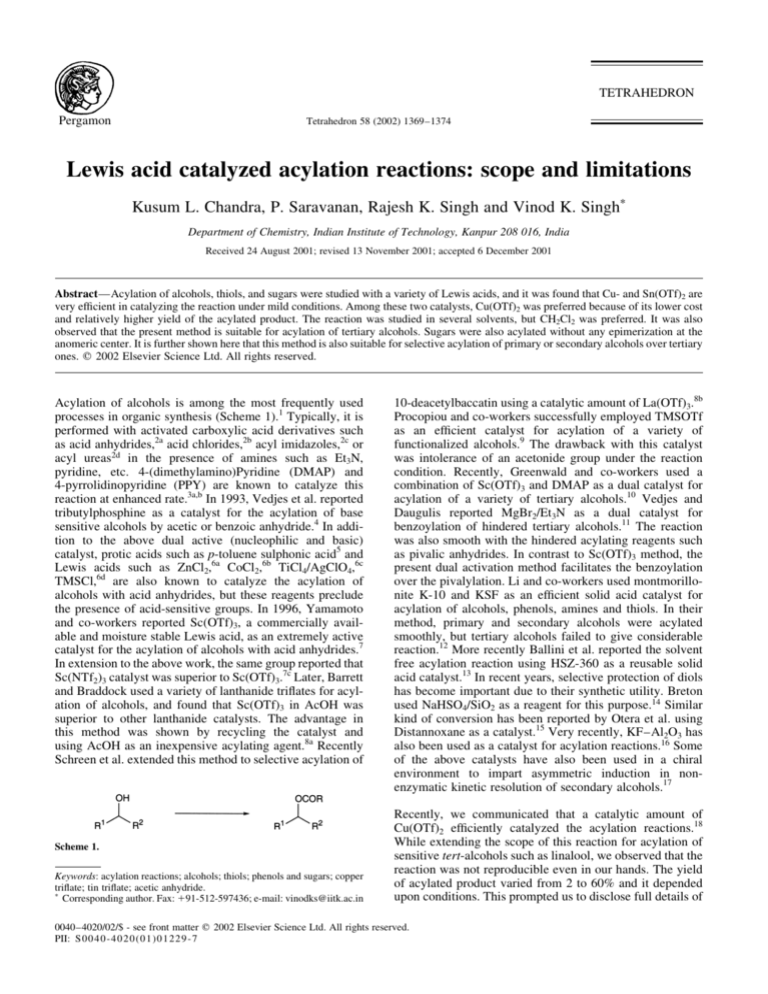
TETRAHEDRON
Pergamon
Tetrahedron 58 (2002) 1369±1374
Lewis acid catalyzed acylation reactions: scope and limitations
Kusum L. Chandra, P. Saravanan, Rajesh K. Singh and Vinod K. Singhp
Department of Chemistry, Indian Institute of Technology, Kanpur 208 016, India
Received 24 August 2001; revised 13 November 2001; accepted 6 December 2001
AbstractÐAcylation of alcohols, thiols, and sugars were studied with a variety of Lewis acids, and it was found that Cu- and Sn(OTf)2 are
very ef®cient in catalyzing the reaction under mild conditions. Among these two catalysts, Cu(OTf)2 was preferred because of its lower cost
and relatively higher yield of the acylated product. The reaction was studied in several solvents, but CH2Cl2 was preferred. It was also
observed that the present method is suitable for acylation of tertiary alcohols. Sugars were also acylated without any epimerization at the
anomeric center. It is further shown here that this method is also suitable for selective acylation of primary or secondary alcohols over tertiary
ones. q 2002 Elsevier Science Ltd. All rights reserved.
Acylation of alcohols is among the most frequently used
processes in organic synthesis (Scheme 1).1 Typically, it is
performed with activated carboxylic acid derivatives such
as acid anhydrides,2a acid chlorides,2b acyl imidazoles,2c or
acyl ureas2d in the presence of amines such as Et3N,
pyridine, etc. 4-(dimethylamino)Pyridine (DMAP) and
4-pyrrolidinopyridine (PPY) are known to catalyze this
reaction at enhanced rate.3a,b In 1993, Vedjes et al. reported
tributylphosphine as a catalyst for the acylation of base
sensitive alcohols by acetic or benzoic anhydride.4 In addition to the above dual active (nucleophilic and basic)
catalyst, protic acids such as p-toluene sulphonic acid5 and
Lewis acids such as ZnCl2,6a CoCl2,6b TiCl4/AgClO4,6c
TMSCl,6d are also known to catalyze the acylation of
alcohols with acid anhydrides, but these reagents preclude
the presence of acid-sensitive groups. In 1996, Yamamoto
and co-workers reported Sc(OTf)3, a commercially available and moisture stable Lewis acid, as an extremely active
catalyst for the acylation of alcohols with acid anhydrides.7
In extension to the above work, the same group reported that
Sc(NTf2)3 catalyst was superior to Sc(OTf)3.7c Later, Barrett
and Braddock used a variety of lanthanide tri¯ates for acylation of alcohols, and found that Sc(OTf)3 in AcOH was
superior to other lanthanide catalysts. The advantage in
this method was shown by recycling the catalyst and
using AcOH as an inexpensive acylating agent.8a Recently
Schreen et al. extended this method to selective acylation of
Scheme 1.
Keywords: acylation reactions; alcohols; thiols; phenols and sugars; copper
tri¯ate; tin tri¯ate; acetic anhydride.
p
Corresponding author. Fax: 191-512-597436; e-mail: vinodks@iitk.ac.in
10-deacetylbaccatin using a catalytic amount of La(OTf)3.8b
Procopiou and co-workers successfully employed TMSOTf
as an ef®cient catalyst for acylation of a variety of
functionalized alcohols.9 The drawback with this catalyst
was intolerance of an acetonide group under the reaction
condition. Recently, Greenwald and co-workers used a
combination of Sc(OTf)3 and DMAP as a dual catalyst for
acylation of a variety of tertiary alcohols.10 Vedjes and
Daugulis reported MgBr2/Et3N as a dual catalyst for
benzoylation of hindered tertiary alcohols.11 The reaction
was also smooth with the hindered acylating reagents such
as pivalic anhydrides. In contrast to Sc(OTf)3 method, the
present dual activation method facilitates the benzoylation
over the pivalylation. Li and co-workers used montmorillonite K-10 and KSF as an ef®cient solid acid catalyst for
acylation of alcohols, phenols, amines and thiols. In their
method, primary and secondary alcohols were acylated
smoothly, but tertiary alcohols failed to give considerable
reaction.12 More recently Ballini et al. reported the solvent
free acylation reaction using HSZ-360 as a reusable solid
acid catalyst.13 In recent years, selective protection of diols
has become important due to their synthetic utility. Breton
used NaHSO4/SiO2 as a reagent for this purpose.14 Similar
kind of conversion has been reported by Otera et al. using
Distannoxane as a catalyst.15 Very recently, KF±Al2O3 has
also been used as a catalyst for acylation reactions.16 Some
of the above catalysts have also been used in a chiral
environment to impart asymmetric induction in nonenzymatic kinetic resolution of secondary alcohols.17
Recently, we communicated that a catalytic amount of
Cu(OTf)2 ef®ciently catalyzed the acylation reactions.18
While extending the scope of this reaction for acylation of
sensitive tert-alcohols such as linalool, we observed that the
reaction was not reproducible even in our hands. The yield
of acylated product varied from 2 to 60% and it depended
upon conditions. This prompted us to disclose full details of
0040±4020/02/$ - see front matter q 2002 Elsevier Science Ltd. All rights reserved.
PII: S 0040-402 0(01)01229-7
1370
K. L. Chandra et al. / Tetrahedron 58 (2002) 1369±1374
Table 1.
Entry
1
2
3
4
5
6
a
Table 3.
Solvent
Time
Yield (%)
CH2Cl2
Toluene
Ether
MeCN
MeNO2
AcOH (no Ac2O)
1
1.5
2
20
22
20
92
90
90
90
86
88a
This reaction was carried out at 608C.
the acylation reaction catalyzed by Lewis acids. At the
outset, 1-phenyl ethanol was chosen as a model substrate
for the acylation reaction. It was treated with 2 equiv. of
acetic anhydride (Ac2O) in the presence of 2.5 mol% of
Cu(OTf)2 in CH2Cl2 at room temperature (Method A).
The reaction was complete in 1 h, and the acetylated product
was isolated in more than 92% yield. Although the reaction
was very clean (by tlc) in CH2Cl2, it was still studied in other
solvents (Table 1). The reaction in non-polar solvents such
as toluene and ether gave similar results, but it was very
slow in polar solvents such as MeCN, and MeNO2. When
acetic acid, instead of Ac2O, was used as acylating reagent
and was taken in excess as a solvent, the reaction was almost
negligible at room temperature. However, comparable
results for acylation were obtained when the reaction was
carried out with an excess of acetic acid at 608C for a longer
period of time (Method B).
The acylation reaction was then studied in the presence
other Lewis acids (Table 2). Sn(OTf)2 and BF3´OEt2 were
equally effective in the acylation reaction. Other Lewis
acids such as ZnCl2, SnCl2, CuCl2, and FeCl3 were not
effective for the above reaction. Although ZnCl2 was
known19 to catalyze acylation of alcohols, it was effective
only when the reaction was performed at re¯ux temperature.
It was observed that ZnCl2 can give good yield of the
acylated product when it was used in stoichiometric amount.
Under identical experimental conditions, it was found that
Cu(OTf)2 is superior to basic reagents (pyridine or DMAP),
which indicated that Cu(OTf)2 was less prone to undergo
deactivation by a carboxylic acid (AcOH), a by-product in
the reaction. Surprisingly, CuCl2 did not catalyze the reaction. The acylation reaction was also studied with other acid
anhydrides such as propionic and benzoic anhydride
(Table 3). Whereas propionic anhydride gave similar yield
Table 2.
Entry
Lewis acids (2.5 mol%)
1
2
3
4
5
6
7
Cu(OTf)2
Sn(OTf)2
BF3´OEt2
ZnCl2
SnCl2´2H2O
CuCl2
FeCl3
Time (h)
Yield (%)
1
1
1
1
28
8
2
92
90
85
05
10
Nil
68
Entry
1
2
3
Lewis acid
Cu(OTf)2
Sn(OTf)2
BF3´OEt2
Yields (%)
(MeCO)2O
(MeCH2CO)2O
92
90
85
90
88
74
(PhCO)2O
Nil
Nil
Nil
of acylated product using copper tri¯ate, tin tri¯ate, and
boron tri¯uoride, benzoic anhydride failed to give any
product even after several hours. Although it was clear
from the above results that both the copper and tin tri¯ates
are ef®cient in catalyzing the acylation reaction, the former
was preferred for further reactions because of its lower cost
and higher stability.
In order to extend the scope of acylation reaction, it was
carried out on a variety of substrates using 2.5 mol% of
copper tri¯ate in CH2Cl2 and results are described in
Table 4. Most of the substrates could be acylated at rt
with acetic anhydride in very short time (Method A). It
was observed that the acylation reaction could also be
carried out with acetic acid (Method B), but the reaction
was very slow at rt. Although primary alcohols could be
acylated in AcOH in the presence of 2.5 mol% of
Cu(OTf)2 at rt, secondary alcohols required higher temperature (60±658C) for completion of the reaction. Phenols,
thiols, and sugars could also be acylated at rt in high yields.
In the case of methyl-a-d-glucopyranoside (entry 34) the
methoxy group at the anomeric center remained intact and
other hydroxyl groups were acetylated. This result was in a
sharp contrast with that of some other Lewis acids, which
acetylated the anomeric methoxy group as well.20 It was
noticed that in a few selected substrates only secondary
alcohols could be acylated and hindered tertiary alcohols
remained untouched (entries 25 and 26).21 It was observed
that sensitive alcohols such as allylic and tertiary alcohols
could not be acylated in an ef®cient manner under Method A
or B. Thus, by taking linalool (entry 22) as a model substrate
for sensitive tertiary alcohols, we studied the reaction in
detail. It was found that the reaction carried under Method
A conditions gave mainly decomposed products. On doing
the same reaction for 12 h at 08C, instead of rt, gave more
than 70% unreacted alcohol. When the reaction was set up at
08C and it was allowed to warm to rt over 12 h, it gave
mainly eliminated products. Other solvents such as toluene
and ether gave similar results. Finally, the acylation of linalool (1 mmol) was tried without using solvent by taking
500 mL of Ac2O in the presence of 1 mol% of Cu(OTf)2
at 2258C. The reaction was virtually complete in 5 h at
this temperature, and 83% yield of the acetylated product
(ratio of linalool acetate and rearranged product91.5:8.5)
was obtained. It must be noted here that any deviation from
the above reaction conditions failed to give a satisfactory
yield in the acylation reaction of linalool. Then, a variety of
sensitive tertiary and allylic alcohols were acylated in high
yield (Table 4; entries 22±24) under the above conditions
(Method C).
K. L. Chandra et al. / Tetrahedron 58 (2002) 1369±1374
Table 4. Cu(OTf)2 catalyzed acetylation reaction
Table 4. (continued)
Entry
Entry
Substrates
Method Time Yield
(h) (%)
A
B
A
B
1
6
0.5
8
99
96
97
94
5
C
7
90
6
C
7
90
1
2
3
4
7
8
9
10
PhCH2OH
PhCH2OH
1371
A
B
A
B
1
14
1
10
Substrates
Method Time Yield
(h) (%)
24
C
1
70
25
A
8
86c
26
A
6
88c
27
A
2
99
28
A
2
88
29
A
3
92
30
A
2
96
31
A
2
87
32
A
5
84
A
A
6
4
91
98
92
94
96
89
11
12
A
B
1
10
98
96
13
14
A
B
0.5
12
98
96
15
16
A
B
1
12
97
96
17
A
3
92
18
A
1
99
19
A
2
90
33
34
20
21
A
B
1
10
99
97
22
C
5
83b
23
C
5
85
d-(1)-Mannitol
Methyl-a-d-glucopyranoside
a
For secondary alcohols, this method required 658C. The reaction was
done at rt unless stated otherwise.
b
The ratio of the linalool acetate vs rearranged product is 91.5:8.5.
c
Only secondary alcohols are acylated.
In order to increase the scope of the present method further,
selective acylation of primary alcohols over secondary ones
in unsymmetrical diols was studied. The acylation reaction
was also compared with the literature method (pyridine and
DMAP) and the results are summarized in Table 5. It is quite
satisfying that the present method is selective in acylation of
primary alcohols in the presence of secondary ones.
1372
K. L. Chandra et al. / Tetrahedron 58 (2002) 1369±1374
Table 5. Selective mono-acylation of unsymmetrical diols with acetic anhydride at rt in CH2Cl2
Entry
Diols
Reagents
Time (h)
Isolated yield (%)
Ratio
18 acetate
Diacetate
1
2
Pyridine, DMAP
Cu(OTf)2 (cat.)
12
2
49
76
40
14
55:45
85:15
3
4
Pyridine, DMAP
Cu(OTf)2 (cat.)
12
2
64
82
31
08
67:33
91:09
5
6
Pyridine, DMAP
Cu(OTf)2 (cat.)
12
2
31
84
58
11
35:65
88:12
7
Cu(OTf)2 (cat.)
2
40
48
46:54
1. Experimental
1
H NMR spectra were recorded on Jeol and Brucker, as
mentioned in the experimental, using TMS as internal standard. Chemical shifts are reported in ppm, and coupling
constants are reported in Hz. IR spectra were recorded on
Perkin±Elmer 580 and 1320 spectrometers.
Figure 1. Proposed mechanism for acylation reactions.
In order to obtain mechanistic information on the acylation
reaction, we carefully monitored the reaction by 400 MHz
NMR spectroscopy. In a set of controlled experiments,
Cu(OTf)2 (2 mol%) in CD2Cl2 was mixed with acetic
anhydride (1 mmol) at room temperature and the 13C
NMR spectrum was recorded. In addition to a signal at d
166 ppm for the anhydride carbonyls, a smaller signal was
seen at d 177.7 ppm (AcOTf). Further, we treated this
mixture with an alcohol (benzyl alcohol, 1 mmol) and
monitored the reaction. It was found that a small peak at
d 11.89 was observed in the 1H NMR spectrum, which
indicated the formation of AcOH in the reaction. On the
basis of these results, we propose that Ac2O reacts with
Cu(OTf)2 to generate the acyl tri¯ate which is attacked by
RXH to give the acylated product and tri¯ic acid. The
tri¯ate ion/tri¯ic acid then reacts with Cu(OTf)OAc to
generate Cu(OTf)2 and acetic acid. The same catalytic
cycle can also be used for Method B where acetic acid
reacts with Cu(OTf)2 to give Cu(OTf)OAc and AcOTf.
The slow formation of these species, in this case, is perhaps
responsible for the slower reaction when using Method B
(Fig. 1).
In summary, we have shown that Cu(OTf)2 is an
ef®cient and versatile catalyst for acylation of alcohols,
phenols, sugars, and thiols. On the basis of NMR studies
we have proposed the catalytic cycle for the acylation
reaction.
Routine monitoring of reactions was performed using silica
gel-G obtained from Acme. All the chromatographic
separations were done by using silica gel (Acme's,
100±200 mesh). Petroleum ether used was of boiling
range 60±808C. Reactions, which needed anhydrous conditions, were run under an atmosphere of dry nitrogen or
argon using ¯ame-dried glasswares. The organic layer was
washed with brine and stored over anhydrous Na2SO4 for
30 min before use. Evaporation of solvents was performed
at reduced pressure, using a BuÈchi rotary evaporator.
Several compounds such as 1-decanyl acetate13 (entries 1
and 2), benzyl acetate7 (entries 3 and 4), cinnamyl acetate6b
(entry 5), geranyl acetate9 (entry 6), (2)-(1R)-menthyl
acetate7 (entries 13 and 14), linalyl acetate7 (entry 22),
17b-acetyl testosterone (entry 29), and b-naphthyl acetate
(entry 30) are commercially available. All the spectroscopic
data of the above compounds matched with those of authentic samples. Similarly, the data for 2-phenyl ethylacetate
(entries 7 and 8),22 2-cyclohexyl ethylacetate (entries 9
and 10),23 and 2,5-diacyloxy hexane (entry 27)23 matched
well with the literature data.
1.1. Typical experimental procedure for the acetylation
of alcohols
Method A. To a mixture of an alcohol (1 mmol) and
Cu(OTf)2 (10 mg, 2.5 mol%) in dry DCM (5 mL) was
added acetic anhydride (190 mL, 2 mmol) at rt. After
being stirred for 2h the solution was quenched with
saturated bicarbonate solution, and the product was
extracted with DCM (three times). The combined organic
extracts were washed with water, and brine. The organic
layer was dried over sodium sulfate and condensed in
vacuo. The resulting crude product was puri®ed by column
K. L. Chandra et al. / Tetrahedron 58 (2002) 1369±1374
chromatography on silica gel using ethyl acetate±petroleum
ether as eluent to give the pure product.
Method B. To a solution of Cu(OTf)2 (10 mg, 2.5 mol%) in
acetic acid (2 mL) was added an alcohol (1 mmol) at rt. The
reaction mixture was stirred at 658C, and monitored by tlc.
After completion, the solution was poured on water, diluted
with CH2Cl2 (15 mL), and stirred for few minutes. The
resulting organic layer was separated and washed with
water, brine, and dried over sodium sulfate. Solvent removal
and puri®cation over silica gel column using EtOAc±
petroleum ether as eluent gave the pure product.
Method C. A mixture of Ac2O (3 mmol) and Cu(OTf)2
(3.6 mg, 1 mol%) was stirred at rt for 10 min. The ¯ask
was cooled to 2258C and an alcohol was added drop by
drop. The reaction mixture was stirred at the same temperature till completion of the reaction (by tlc). The reaction
mixture was quenched at the same temperature by the
addition of aq. NaHCO3. It was diluted with CH2Cl2 and
organic layer was separated. It was washed with water,
brined, and dried. The resulting crude product was puri®ed
by column chromatography on silica gel using ethyl
acetate±petroleum ether as eluent to give the pure product.
1.1.1. 4-tert-Butyl cyclohexylacetate (entries 11 and 12).
Yield 98% as a viscous liquid; Rf 0.90 (10% EtOAc in
petroleum ether); IR (neat) 1720, 1250 cm21; 1H NMR
(CCl4, 400 MHz) d 0.85 (s, 9H), 0.95±1.34 (m, 5H), 1.81
(m, 2H), 1.99 (m, 2H), 2.02 (s, 3H), 4.62 (tt, J11.2, 4.4 Hz,
1H). Anal. calcd for C12H22O2: C, 72.73; H, 11.11. Found:
C, 72.86; H, 11.20.
1.1.2. (2)-(1R)-Methyl acetate (entries 13 and 14). Yield
97% as a colorless liquid; Rf 0.90 (10% EtOAc in petroleum
ether); [a ]D252117.7 (c 1.0, CHCl3) {lit.7b [a ]D20
280.58 (c 8.0, benzene)}.
1.1.3. (1) Methyl (S)-a-acetoxy phenylacetate (entries 15
and 16). Yield 97% as a colorless liquid; Rf 0.85 (20%
EtOAc in petroleum ether); [a ]D251134.2 (c 2.4,
CHCl3); IR (neat) 2960, 1735, 1250, 830, 760 cm21; 1H
NMR (CDCl3, 400 MHz) d 2.18 (s, 3H), 3.69 (s, 3H),
5.95 (s, 1H), 7.33±7.46 (m, 5H). Anal. calcd for
C15H20O4: C, 68.18; H, 7.57. Found: C, 68.66; H, 7.42.
1373
1.1.6. 3,4-Dicarbomethoxy cyclopentenyl-1-acetate
(entry 19). Yield 90% as a viscous liquid; Rf 0.60 (25%
EtOAc in petroleum ether); IR (neat) 1735, 1710,
1250 cm21; 1H NMR (CDCl3, 400 MHz) d 2.09 (s, 3H),
2.16±2.21 (m, 4H), 3.74 (s, 6H), 4.16 (m, 2H), 5.19 (m,
1H). Anal. calcd for C11H16O6: C, 54.09; H, 6.56. Found:
C, 54.56; H, 6.46.
1.1.7. 1-Acetoxy-2-phenyl cyclohexane (entries 20 and
21).24 Yield 99% as a liquid; Rf 0.45 (5% EtOAc in
petroleum ether); IR (neat) 3010, 2960, 1730, 1250, 830,
750 cm21; 1H NMR (CDCl3, 400 MHz) d 1.25±2.12 (bm,
8H), 1.75 (s, 3H), 2.65 (ddd, J12.2, 11.0, 3.9 Hz, 1H), 4.97
(ddd, J10.5, 4.4 Hz, 1H), 7.24 (m, 5H, aromatics); MS (EI,
m/z): 218 (M1), 175, 158 (base peak).
1.1.8. Linalyl acetate (entry 22).7 Yield 83% (based on
recovered linalool) as a colorless liquid; Rf 0.60 (5%
EtOAc in petroleum ether); IR (neat) 3010, 1720,
1250 cm21; 1H NMR (CDCl3, 400 MHz) d 1.54 (s, 3H),
1.59 (s, 3H), 1.64 (s, 3H), 1.76 (m, 2H), 1.86 (m, 2H),
2.00 (s, 3H), 4.58 (m, 0.085H, 8.5%, rearranged isomer),
5.13 (m, 3H), 5.96 (dd, J11, 5.6 Hz, 0.915H, 91.5%).
1.1.9. 1-Allyl-4-tert-butyl-1-cyclohexyl acetate (entry 23).
Yield 85% as a liquid; Rf 0.60 (5% EtOAc in petroleum
ether); 1H NMR (CDCl3, 400 MHz) d 0.85 (s, 9H), 0.99
(m, 2H), 1.2 (m, 3H), 1.56 (m, 2H), 1.99 (s, 3H), 2.38 (m,
2H), 2.62 (d, J7.6 Hz, 2H), 5.03 (d, J3.4 Hz, 1H), 5.06
(s, 1H), 5.76 (m, 1H). Anal. calcd for C15H26O2: C, 75.63; H,
10.92. Found: C, 75.46; H, 11.02.
1.1.10. 1-Phenyl ethynyl-1-cyclohexyl acetate (entry 24).
Yield 70% as a liquid; Rf 0.60 (5% EtOAc in petroleum
ether); 1H NMR (CDCl3, 400 MHz) d 1.28 (m, 1H), 1.67
(m, 7H), 2.02 (s, 3H), 2.47 (d, J11 Hz, 2H), 7.3 (m, 5H),
13
C NMR (CDCl3, 100 MHz) d 22.0, 25.2, 36.1, 82.3, 124.4,
126.8, 128.1, 145.5, 169.4. Anal. calcd for C16H18O2: C,
79.34; H, 7.44. Found: C, 79.26; H, 7.52.
1.1.11. TADDOL diacetate (entry 25). Yield 86% as a
white solid; mp 172±1758C, [a ]D252105.1 (c 1.0,
CHCl3); Rf 0.80 (20% EtOAc in petroleum ether); IR
(KBr) 3020, 2950, 1735, 1710, 1210, 830, 750 cm21; 1H
NMR (CDCl3, 400 MHz) d 1.62 (s, 6H), 6.31 (s, 2H),
7.12±7.34 (m, 16H), 7.59 (d, J8 Hz, 4H). Anal. calcd
for C32H30O6: C, 75.29; H, 5.88. Found: C, 75.46; H, 5.90.
1.1.4. tert-Butyl (S)-3-acetoxy-3-phenyl propanoate
(entry 17). Yield 92% as a colorless liquid; Rf 0.50 (10%
EtOAc in petroleum ether); IR (neat) 1720, 1640, 1250,
760 cm21; 1H NMR (CDCl3, 400 MHz) d 1.39 (s, 9H),
2.03 (s, 3H), 2.65±2.70 (dd, J15, 6 Hz, 1H), 2.84±2.90
(dd, J15, 8 Hz, 1H), 6.11±6.15 (dd, J9, 5 Hz, 1H), 7.27±
7.37 (m, 5H). Anal. calcd for C15H20O4: C, 68.18; H, 7.57.
Found: C, 68.26; H, 7.62.
1.1.12. 2-Hydroxy-1,2,2-triphenylethylacetate (entry 26).
Yield 88%; white solid, mp 70±728C; Rf 0.70 (20% EtOAc
in petroleum ether); IR (KBr) 1730 cm21; 1H NMR (CDCl3,
400 MHz) d 1.97 (s, 3H), 7.06 (m, 1H), 7.12±7.4 (m, 15H).
MS (EI, m/z): 308 (M1). Anal. calcd for C22H20O3: C, 79.51;
H, 6.02. Found: C, 79.66; H, 6.12.
1.1.5. 1-Cyano heptanyl-1-acetate (entry 18). Yield 99%
as a viscous liquid; Rf 0.40 (5% EtOAc in petroleum ether);
IR (neat) 2250, 1730, 760 cm21; 1H NMR (CDCl3,
400 MHz) d 0.89 (t, J6.5 Hz, 3H), 1.30 (m, 6H), 1.49
(m, 2H), 1.88 (m, 2H), 2.13 (s, 3H), 5.31 (t, J7.5 Hz,
1H); MS (EI, m/z): 182 (M1). Anal. calcd for C10H17NO2:
C, 65.57; H, 9.28; N, 7.65. Found: C, 65.38; H, 9.32; N,
7.74.
1.1.13. 1,4 Bis (S,S)-(t-butyl 1-propanoyl-1-acetoxy)xylene (entry 28). Yield 88% as a white solid; mp 133±
1358C; Rf 0.50 (20% EtOAc in petroleum ether);
[a ]D25117.9 (c 1.0, CHCl3); IR (KBr) 3010, 2980,
1735, 1710, 1670, 830, 760 cm21; 1H NMR (CDCl3,
400 MHz) d 1.39 (s, 18H), 2.17 (s, 6H), 2.62±2.67 (dd,
J15, 6 Hz, 2H), 2.81±2.87 (dd, J15, 9 Hz, 2H), 6.09±
6.12 (m, 2H), 7.34 (s, 4H, aromatics); 13C NMR (CDCl3,
1374
K. L. Chandra et al. / Tetrahedron 58 (2002) 1369±1374
100 MHz) d 21.04, 27.92, 42.57, 72.01, 81.17, 126.85,
139.40, 168.81, 169.72. Anal. calcd for C24H34O8: C, 64.0;
H, 7.55. Found: C, 64.12; H, 7.43.
1.1.14. 2,2 0 -Binaphthol diacetate (entry 31).13 Yield 87%
as a white crystalline material; mp 101±1038C; Rf 0.60
(20% EtOAc in petroleum ether); IR (KBr) 1735, 1210,
760 cm21; 1H NMR (CDCl3, 400 MHz) d 1.88 (s, 6H),
7.16±7.46 (m, 8H), 7.91±8.02 (dd, J15, 9 Hz, 4H); 13C
NMR (CDCl3, 100 MHz) d 20.54, 121.80, 123.30, 125.60,
126.10, 126.60, 127.92, 129.43, 131.40, 133.21, 146.60,
169.32; MS (EI, m/z): 370 (M1), 328, 285 (base peak).
1.1.15. Cyclohexyl thioacetate (entry 32). Yield 84% as a
colorless liquid; Rf 0.80 (2% EtOAc in petroleum ether); IR
(neat) 1730 cm21; 1H NMR (CCl4, 60 MHz) d 1.50 (m,
10H), 2.25 (s, 3H), 3.38 (m, 1H). Anal. calcd for
C8H14SO: C, 60.75; H, 8.86; S, 20.25. Found: C, 60.53; H,
8.92; S, 20.08.
1.1.16. 1,2,3,4,5,6-Hexa-O-acetyl-d
d-mannitol (entry 33).
Yield 91% as a white crystalline solid; mp 80±838C
{lit.20b mp 123±1248C}; [a ]D25134.4 (c 1.2, CHCl3)
{lit.20b [a ]D25127 (c 1.0, CHCl3).
1.1.17. 2,3,4,6-Tetra-O-acetyl-a-d
d-methylglucopyranose
(entry 34). Yield 97% as a white solid; mp 102±1048C
{lit.20b mp 100±1018C}; [a ]D251117.1 (c 9.1, CHCl3)
{lit.20b [a ]D251130 (c 1.0, CHCl3).
Acknowledgements
V. K. S. thanks DST (Government of India) for the
Swarnajayanti fellowship award (1998). K. L. C. thanks
CSIR for research fellowship.
References
1. Verley, A.; BoÈlsing, F. Ber. Disch Chem. Ges. 1901, 34, 3354.
2. (a) Zhdanov, R. I.; Zhendarova, S. M. Synthesis 1975, 222.
(b) Stork, G.; Takahashai, T.; Kawamoto, I.; Suzuki, T. J. Am.
Chem. Soc. 1978, 100, 8272. (c) Kamijo, T.; Harada, H.;
Iizuku, K. Chem. Pharm. Bull. 1984, 32, 5044. (d) Dhanon,
M. K.; Olsen, R. K.; Ramaswamy, K. J. Org. Chem. 1982, 47,
1962.
3. Reviews: (a) Hoȯe, G.; Steglich, V.; Vorbruggen, H. Angew.
Chem., Int. Ed. Engl. 1978, 17, 569. (b) Scrieven, E. F. V.
Chem. Soc. Rev. 1983, 12, 129.
4. (a) Vedjes, E.; Diver, S. T. J. Am. Chem. Soc. 1993, 115, 3358.
(b) Vedjes, E.; Bennet, N. S.; Conn, L. M.; Diver, S. T.;
Gingras, M.; Lin, S.; Oliver, P. A.; Peterson, M. J. J. Org.
Chem. 1993, 58, 7286.
5. Cope, A. C.; Herrick, E. C. Organic Syntheses, Collect. Vol. 4;
Wiley: New York, 1963; p 304.
6. (a) Baker, R. H.; Bordwell, F. G. Organic Syntheses, Collect.
Vol. 3; Wiley: New York, 1955; p 141. (b) Iqbal, J.;
Srivastava, R. R. J. Org. Chem. 1992, 57, 2001. (c) Miyashita,
M.; Shiina, I.; Miyoshi, S.; Mukaiyama, T. Bull. Chem. Soc.
Jpn 1993, 66, 1516. (d) kumareswaran, R.; Gupta, A.; Vankar,
Y. D. Synth. Commun. 1997, 27, 277.
7. (a) Ishihara, K.; Kubota, M.; Kurihara, H.; Yamamoto, H.
J. Am. Chem. Soc. 1995, 117, 4413. (b) Ishihara, K.; Kubota,
M.; Kurihara, H.; Yamamoto, H. J. Org. Chem. 1996, 61,
4560. (c) Ishihara, K.; Kubota, M.; Yamamoto, H. Synlett
1996, 265.
8. (a) Barrett, A. G.; Braddock, D. C. J. Chem. Soc., Chem.
Commun. 1997, 351. (b) Damen, E. W. P.; Braamer, L.;
Scheeren, H. W. Tetrahedron Lett. 1998, 39, 6081.
9. (a) Procopiou, P. A.; Baugh, S. P. D.; Flack, S. S.; Inglis,
G. G. A. J. Chem. Soc., Chem. Commun. 1996, 2625.
(b) Procopiou, P. A.; Baugh, S. P. D.; Flack, S. S.; Inglis,
G. G. A. J. Org. Chem. 1998, 63, 2342.
10. Zhao, H.; Pendri, A.; Greenwald, R. B. J. Org. Chem. 1998,
63, 7559.
11. Vedjes, E.; Daugulis, O. J. Org. Chem. 1996, 61, 5702.
12. Li, A.-X.; Li, T.-S.; Ding, T.-H. J. Chem. Soc., Chem.
Commun. 1997, 1389.
13. Ballini, R.; Bosica, G.; Carloni, S.; Ciaralli, L.; Maggi, R.;
Sartori, G. Tetrahedron Lett. 1998, 39, 6049.
14. Breton, G. W. J. Org. Chem. 1997, 62, 8952.
15. Orita, A.; Mitsutome, A.; Otera, J. J. Org. Chem. 1998, 63,
2420.
16. Yadav, V. K.; Babu, K. G.; Mittal, M. Tetrahedron 2001, 57,
7047.
17. Review: Somafai, P. Angew. Chem., Int. Ed. Engl. 1997, 36,
2731.
18. Saravanan, P.; Singh, V. K. Tetrahedron Lett. 1999, 40, 2611.
19. Baker, R. H.; Bordwell, F. G. Organic Synthesis Collect. Vol.
3; Wiley: New York; p 141.
20. (a) Christensen, G. M. J. Org. Chem. 1962, 27, 1442.
(b) Dasgupta, F.; Singh, P. P.; Srivastava, H. C. Carbohydr.
Res. 1980, 80, 346. (c) Bhaskar, P. M.; Loganathan, D.
Tetrahedron Lett. 1998, 39, 2215 and references cited therein.
(d) McPhail, D. R.; Lee, J. R.; Fraser-Reid J. Am. Chem. Soc.
1992, 114, 1905.
21. In our preliminary communication (Ref. 17), we have
inadvertently reported that all the hydroxyl groups are
acylated.
22. Bianchi, D.; Cesti, P.; Battistel, E. J. Org. Chem. 1988, 53,
5531.
23. Persson, B. A.; Larsson, A. L. E.; Ray, M. L.; Backvall, J.-E.
J. Am. Chem. Soc. 1999, 121, 1645.
24. (a) Oriyama, T.; Hori, Y.; Imai, K.; Sasaki, R. Tetrahedron
Lett. 1996, 37, 8543. (b) Oriyama, T.; Imai, K.; Hosoya, T.;
Sano, T. Tetrahedron Lett. 1998, 39, 397. (c) Oriyama, T.;
Imai, K.; Sano, T.; Hosoya, T. Tetrahedron Lett. 1996, 37,
8543.





